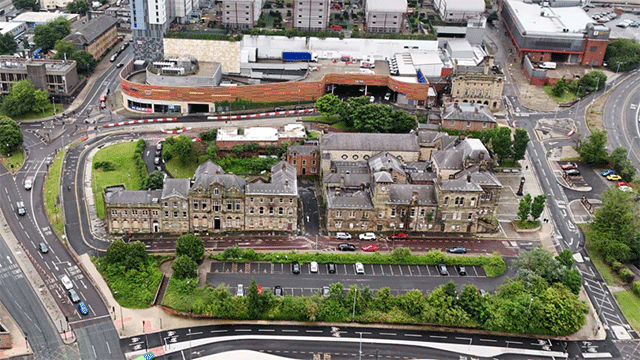High street low: As rising rents and falling sales hit Woolworths’ traditional retail business, the companyis banking on a property revamp and on its growing entertainment wholesale arm to turn its fortunesaround. But will this be enough?
Embattled pic’n’mix retailer Woolworths is ploughing ahead with a revamp of its property portfolio in the hope that moves to “right-size” its network of stores will soon pay off and convince the City that there is still a place for it on the high street.
The 99-year-old retailer, whose trademark red logo/fascia has long been a landmark in UK high streets, is best known for its sweets, toys and music, but it has fallen on hard times in recent years with its share price slumping to an all-time low in January following a “very challenging” Christmas.
Despite a trading update, which indicated a 3.2% drop in like-for-like sales over the 49 weeks to 12 January, chief executive Trevor Bish-Jones struck an upbeat note, saying he expected Woolworths’ retail operation to return to profitability this year.
With the group’s preliminary results due out on April 2, just as EG Retail went to press, the Square Mile is going to take some convincing.
In December, leading investment bank Citigroup savaged Woolworths’ core retail business as “worthless”, saying the only value lay in the group’s entertainment wholesale arm, Entertainment UK and its joint venture with the BBC – 2entertain – a view echoed by Andrew Wade, retail analyst at stockbroker Seymour Pierce.
“A lot of the value of the business is in EUK and 2entertain – the retail chain is pretty much worthless,” says Wade. “The business is barely breaking even, and it’s not expected to improve going forward.”
While most analysts tend to agree that management is doing all the right things, many believe that as a retail concept, Woolworths has simply passed its sell-by date.
“There are about 820 stores which have a couple of billion in turnover but they’re not making any money,” says one analyst. “Woolworths’ portfolio is leasehold and it is facing an increasingly high rent bill. As a format, life has probably overtaken it.”
Woolworths’ traditional business of confectionery and music is “being trampled on” by the supermarkets, he adds, and the retailer is also suffering from the general malaise afflicting the high street as a result of a slowdown in consumer spending.
Woolworths is the first to admit to the pain of increasing rental levels. Trevor Bish-Jones, who has been referred to as “the most embattled chief executive in the high street”, admits that rising rents have forced the group to rethink some of its property portfolio. “In terms of net profits,I would make more money than Sainsbury’s and Asda, but I have to pay the rent,” he said last year.
Spiralling rents were also the driving factor behind Woolworths’ £385m asset-backed loan deal in February, via ADM Capital Management, Burdale Financial and GMAC, which saw the retailer narrowly stave off a credit crunch.
With almost no freehold property, any drop in sales can be devastating for Woolworths’ profits because the company rents practically all of its 820 stores.
About 18 months ago, Woolworths said it was revamping its property portfolio to refocus on smaller stores in secondary locations.
At the time, Bish-Jones was quoted as saying that Woolworths was hoping to open 100 new stores over the next four years, while closing or relocating up to 30 stores in more expensive locations.
So far, that has translated into the disposal of five stores over the past year, the most recent being a 32,000 sq ft outlet in Luton’s Arndale centre. In coming months, the retailer is to leave its 40,000 sq ft unit in Tamworth, and is thought to be considering the downsize of an outlet in Ilford.
“The company has refocused its acquisition strategy to concentrate on the traditional high street within smaller market towns,” Woolworths says. “As a result of increased rents, which have largely been driven by fashion occupiers in some larger city centres, Woolworths has closed a limited number of stores in Leicester, Southampton, York and Glasgow’s Braehead Shopping Centre.”
Says one analyst: “Where they have been caught out on rental increases is in larger stores in city centres, which are also the stores that are suffering from competition from the supermarkets, as opposed to their small stores in smaller market towns where the rental increases have been insignificant and Woolworths have good market share.
“Woolworths’ property strategy is to effect downsizing on oversized stores in the main centres through subletting part or surrendering part, or through concessions,” the analyst adds, pointing to a successful tie-up with value fashion retailer Peacocks.
Peacocks concessions are already operating in six out-of-town former Big W stores (see panel, right), but in February, the fashion chain opened its first town centre concession, taking an 8,000 sq ft space on the first floor of Woolworths in Watford. The chain is to open a second 4,000 sq ft concession in Woolworths Guildford in May.
The focus now is to shrink the store footprint to its optimum trading format of 15,000 sq ft, with the same again as storage. This is likely to see the company downsizing its remaining out-of-town stock, some of which are up to 80,000 sq ft.
“Three-quarters of the portfolio is in the right format and the right place, and maybe only 20% of it is oversized – it’s a very small percentage compared with the overall number of stores,” says the analyst.
“Some of the stores are just not profitable,” says Sanjay Vidyarthi, retail analyst at Dresdner Kleinwort. “Where they can, they will relocate to smaller and cheaper sites. It’s achievable longer term but with the headwinds Woolworths is facing, it will take some time.”
Woolworths is banking on a number of small, multi-channel stores to take it forward. It is hoping to attract more customers by turning its stores into outlets where customers can both put in an order and collect items ordered online – in a “click and collect” scheme.
In the past year, Woolworths, which is being advised on its expansion plans by Savills, has acquired eight smaller stores in town-centre locations. “With some of these open and performing very well, there is a programme in place to open further stores throughout 2008,” says the company.
Last July saw the opening of a 12,000 sq ft store in Shaftesbury, Dorset, as well as the acquisition of another 12,000 sq ft unit in Bittern, Southampton. In Northern Ireland, Woolworths has taken a 15-year lease on a new 10,050 sq ft unit in Antrim’s Castle. It has also agreed to take a 9,000 sq ft unit in the recently refurbished Park Centre shopping scheme in south-west Belfast. Also, it has acquired stores in Nailsea, north Somerset, and Brierly Hill in the West Midlands.
David Justice, a director at Savills, says: “With an active acquisition programme in place following the successful opening of several multi-channel stores last year, Woolworths has started 2008 with a very positive outlook.”
Store closures across the UK
Leicester January 2007 saw the closure of Woolworths’ two-storey, 25,893 sq ft store in Humberstone Gate, Leicester, ending a 92-year association with the town. The Leicester store, which opened on another site in March 1915, was one of the first in the UK.
Southampton In September 2007, Woolworths surrendered the lease on its 22,500 sq ft store in Southampton’s Above Bar Street, from which it had been trading since 1923. The move came after landlord UBS Triton Property Fund offered to buy back the lease 10 years early. The property was taken over by designer discount store TK Maxx and shoe shop Dolcis.
Glasgow In January 2008, Woolworths closed its 16,000sq ft store in Glasgow’s Braehead centre. With a rent review on the horizon, the landlord took a surrender and relet the property to fashion chain New Look.
York Also in January, Woolworths closed down its 15,000 sq ft store in York’s Spurriergate after trading in the city for more than 80 years. The decision to leave the property, located in one of York’s most high-profile retail locations, was taken after landlord Aviva Staff Pension Fund offered to surrender the lease and relet the property to Boots the Chemist.
Luton At the end of March, Woolworths closed its store in Luton’s Arndale Centre. When it opened in 1973, the two-storey, 32,000 sq ft store was one of the largest Woolworths in the country. The premises are to be taken over by Marks & Spencer.
Elsewhere Woolworths is also due to close a 40,000 sq ft out-of-town unit at Ventura Retail Park in Tamworth, with the lease again being taken over by Marks & Spencer.
Media distributionproves key to profit
Woolworths may be best known for its 820-strong chain of shops – but it is actually the group’s media and distribution businesses that generates most of its profits. Entertainment UK, its wholesale entertainment business which supplies books, music and DVDs to retailers such as Virgin Retail and Asda, is the fastest-growing part of the group with a turnover of £1.6bn. While the retail arm has been struggling with rising rents and falling sales, EUK has gone from strength to strength.
The retailer also owns a 40% stake in 2entertain, a joint venture with the BBC, which sells DVDs such as Planet Earth, Little Britain and Dr Who.
Woolworths has considered splitting off the group’s wholesale and retail arms, but chief executive Trevor Bish-Jones says such a move would not be contemplated until retail returned to profitability.
Media reports suggested a break-up could happen as early as March when Woolworths and BBC World both have an option to buy each other out. Analysts believe Woolworths’ stake in 2entertain could raise around £200m. But no decision had been made as EG Retail went to press.
Misadventures in retailing: the big W
Woolworths launched its Big W retail format in 1999 to take advantage of changing retail trends by providing a broader product across a more comprehensive range of store locations. The company positioned itself as a high volume out-of-town superstore offering products at competitive prices in stores of up to 100,000 sq ft.
In 2004, the group said it was going to trim its 21 Big W stores to between 35-40,000 sq ft. “Woolworths had about 20 Big W stores but it scaled those back because it didn’t have the range and didn’t get the footfall,” one analyst says. “It was a nice try, but an expensive mistake.”
Today, there are 17 former Big W stores, all of which are Woolworths-branded. The Tamworth store is due to shut later this year.
Former Big W stores
? Edinburgh
? Bristol – Filton
? Rotherham
? Glasgow
? Stockton On Tees (OOT)
? Bradford
? Tamworth
? Newark
? Norwich
? Belfast
? Birmingham
? Newport
? Beckton
? Manchester
? Loughborough
? Byker
? Bristol – Imperial Park










